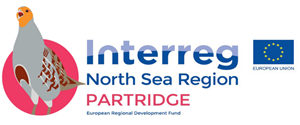 The GWCT is lead partner of a pioneering cross-border North Sea Region Interreg programme project called PARTRIDGE (Protecting the Area’s Resources Through Researched Innovative Demonstration of Good Examples) that will run to 2023. Together with twelve other partner organisations from the Netherlands, Belgium, Germany, Denmark, Sweden, Scotland and England, the project is showcasing how farmland wildlife can be restored by up to 30% at ten 500-hectare demonstration sites (two in each country). In the UK, the four PARTRIDGE demonstration sites (Rotherfield Park and the Allerton Project in England, and Whitburgh and Balgonie in Scotland) are all managed by GWCT staff together with their local partners.
The GWCT is lead partner of a pioneering cross-border North Sea Region Interreg programme project called PARTRIDGE (Protecting the Area’s Resources Through Researched Innovative Demonstration of Good Examples) that will run to 2023. Together with twelve other partner organisations from the Netherlands, Belgium, Germany, Denmark, Sweden, Scotland and England, the project is showcasing how farmland wildlife can be restored by up to 30% at ten 500-hectare demonstration sites (two in each country). In the UK, the four PARTRIDGE demonstration sites (Rotherfield Park and the Allerton Project in England, and Whitburgh and Balgonie in Scotland) are all managed by GWCT staff together with their local partners.
Project aims
- Demonstration of how to reverse farmland biodiversity loss at ten 500ha sites by 30% by 2023.
- Use the grey partridge as a flagship species for management plans at demonstration sites.
- Influence agri-environment policy and showcase how to enthuse local stakeholders to conserve farmland wildlife.
About the project
PARTRIDGE is a cross-border Interreg project that demonstrates how to reverse the ongoing decline of farmland wildlife using science-based management plans (which include the establishment of 7% high-quality habitat, supplementary winter feeding during the winter hungry gap, and legal predator management) and a bottom-up approach implemented by more than 100 local farmers, hunters, volunteer groups, other stakeholders and government agencies. The local management packages are tailored to the needs of the project’s farmland wildlife ambassador, the grey partridge.
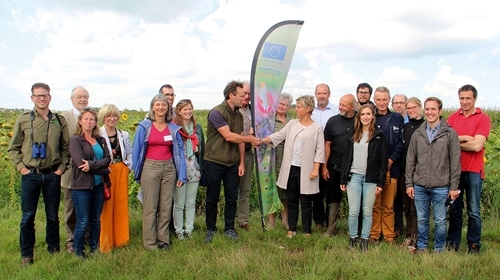 PARTRIDGE project lead co-ordinator Francis Buner welcoming Belgian’s
PARTRIDGE project lead co-ordinator Francis Buner welcoming Belgian’s
Environment Minister Joke Schauvliege during the Belgian project launch.
The grey partridge is one of the best indicators of farmland ecosystem health; where partridges thrive, biodiversity is high and ecosystem services remain intact. In areas where few or no partridges exist, the farm environment is typically much degraded.
PARTRIDGE’s most effective habitat measures are partridge-tailored flower mixes, which provide suitable habitat all year round, together with beetle banks, winter stubbles and arable margins. Each project has developed its own improved and locally adapted PARTRIDGE mixes, based on sharing knowledge. In the UK, the PARTRIDGE mixes have been designed together with Oakbank and Kings Seeds.
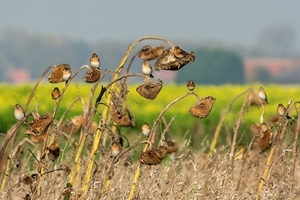 Farmland habitat measures supported by agri-environment schemes, which provide vital financial aid to farmers to help them manage their land in ways beneficial to wildlife and the broader ecosystem, are not new. They are a widespread strategy aimed at recovering farmland biodiversity across Europe under Pillar 2 of the Common Agricultural Policy (CAP).
Farmland habitat measures supported by agri-environment schemes, which provide vital financial aid to farmers to help them manage their land in ways beneficial to wildlife and the broader ecosystem, are not new. They are a widespread strategy aimed at recovering farmland biodiversity across Europe under Pillar 2 of the Common Agricultural Policy (CAP).
However, despite their huge potential, in practice these schemes have not delivered on a large scale. There are several reasons for this: every member state has designed its own scheme (often without consulting each other’s experiences) and most have ended up with schemes that are unable to reverse biodiversity loss, even on a local scale. Current measures are often developed on poor ground, are of insufficient quality and make up less than 2% of the farmed area. A further weakness is the lack of in-depth advice available to farmers and a failure to encourage other local stakeholders to take an active part in management plans.
In England, the Higher Level Stewardship (HLS) scheme, one of the most thought-through schemes available in the EU – which the GWCT helped to shape – has reversed biodiversity loss in many local cases (for example at the Allerton Project at Loddington, the Rotherfield Park Demonstration Project or the Arundel grey partridge recovery project, to name just a few). Nevertheless, English farmland wildlife keeps declining on a national level and hence one could argue that even one of the best schemes in Europe has not managed to address the problem successfully.
PARTRIDGE also has the ambition to influence the post-Brexit agri-environment policy and the current CAP talks for the post-2020 period. Target 3a of the current EU Biodiversity Strategy to 2020 aims to “increase the contribution of agriculture to maintaining and enhancing biodiversity”. However, hardly a week goes by without reports of the continuing decline of farmland wildlife across Europe. This makes for depressing reading, especially considering that the factors responsible for farmland biodiversity loss are well understood: a combination of habitat loss, pesticides and predation.
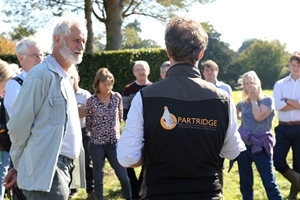
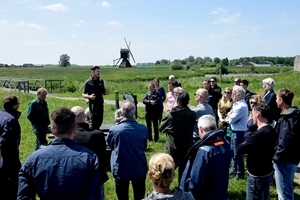
To highlight the urgency of stopping the continuing loss of farmland wildlife, PARTRIDGE puts great emphasis on communication activities and in-depth advice. The demonstration sites are used to showcase best practice, not only to local farmland stakeholders, but also to local, regional and national decision-makers and agencies, especially those involved in agri-environmental schemes and agri-policy in general.
Early successes
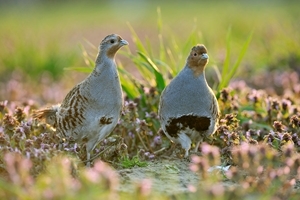 Halfway through the project, PARTRIDGE has achieved considerable early successes, in particular an exceptional uptake of high-quality habitat measures on almost all ten demonstration sites. This has resulted in the creation of habitat improvements that already exceed 7% of the farmed areas at most sites, which significantly exceed levels typical of current agri-environmental schemes across Europe. Across the partner countries, new or much-improved PARTRIDGE flower mixes have been introduced and, in the Netherlands and Belgium, beetle banks have been established for the first time.
Halfway through the project, PARTRIDGE has achieved considerable early successes, in particular an exceptional uptake of high-quality habitat measures on almost all ten demonstration sites. This has resulted in the creation of habitat improvements that already exceed 7% of the farmed areas at most sites, which significantly exceed levels typical of current agri-environmental schemes across Europe. Across the partner countries, new or much-improved PARTRIDGE flower mixes have been introduced and, in the Netherlands and Belgium, beetle banks have been established for the first time.
To date, more than 2,600 people have visited the PARTRIDGE demonstration sites, among them prominent visitors such as the Danish and Belgian environment ministers, the EU Commissioner for Agriculture and Rural Development and the UK’s Secretary of State.
Additionally, cross-border visits for all stakeholders, including farmers and landowners, are being organised, resulting in a flow of information exchange and enthusiasm among all involved. At most of the project sites, PARTRIDGE has already managed to ignite a sense of pride for partridge/wildlife-friendly farming.
Read more
For more information, please visit the project’s website.
Photo credit
Bramblings photo © Jannie Timmer